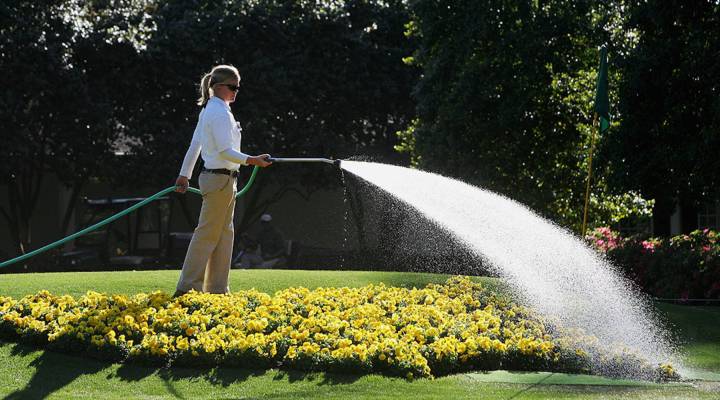
Paying for beauty in a drought

Tess Vigeland: It may have been pushed out of the headlines this week, but the worst drought in 50 years is still spreading across the U.S. At least moderate levels of drought have now enveloped more than 64 percent of the country. That’s bad news for farmers — and for gardeners!
Americans spent $29 billion on their gardens last year, according to the National Gardening Association. And the drought is forcing many people to make some hard and expensive horticultural choices.
From St. Louis, Adam Allington reports.
Adam Allington: Julie Housley is president of Garden Society of Wildwood, Mo. And for those of you who aren’t hip, this is a collection of green thumbs who take their plants and lawns very seriously.
Except this year, Julie says she decided to stop watering the lawn completely.
Julie Housley: I’ve just watched it turn brown and the leaves are coming down from the trees. It almost looks like fall some days.
Walking through her back yard, Housley explains there just isn’t enough time in the day to water everything, especially when Mother Nature’s gone on strike.
Housley: And I had a bed of perennials back here too and I’ve just let those go. I haven’t done anything with that. Hopefully some of it will come back.
In an extreme year like this, Housley’s had to practice a kind of garden triage, electing to save costlier plants like these ornamental maples recently planted next to her patio.
Housley: And so I’ve had to really make sure that they survive, because they’re in the hundreds of dollars, where the bushes are $50s and so forth. Altogether it was around $3,000, not including putting everything in and so forth.
With many communities facing restrictions on water use, or limited capacity from shallow wells, financial and environmental wisdom suggests that water just has no business being used on lawns.
Chip Tynan: By all means, forget your lawns; apply it to your trees.
Chip Tynan manages the Horticulture Answers Service at the Missouri Botanical Garden. In drought years, he says it’s especially necessary to water young trees regularly, but even mature ones shouldn’t be overlooked.
Tynan: The costs that could be incurred by a homeowner to remove and replace a tree could run into the thousands of dollars. Contrast that with, say for instance, if you had to replace your lawn, the main costs are going to start with just a bag of seeds.
But with monthly water bills reaching well into the hundreds of dollars, the smart money for die-hard gardeners isn’t on trees at all. Ellen Barredo is a manager at Bowood Farms Nursery in St. Louis.
Ellen Barredo: Seed gardening right now — huge! Just amazing how many people are coming in. So a lot of people have vegetable gardens not doing so well, you have to decide what you want to pull out, get rid of, get that soil prepared and get your fall seeds started.
In addition to seed and container gardening, Barredo says she’s seen a huge uptick in demand for drought-adapted varieties like this red-flowering plant here.
Barredo: For example, a tropical plant that might do well in a container, and still you provide you color is this bougainvillea right here. It’s in full bloom right now; it will take the heat. This is a southern plant and it will do quite nicely.
According to climate scientists last July was the hottest ever recorded in the lower 48 states.
But even in times like these homeowners shouldn’t necessarily give up on planting on altogether. Dryland gardening can present an interesting challenge; for instance many herbs actually do quite well in dry conditions. And even if some plants die, Chip Tynan from the Missouri Botanical Garden says that money wasn’t wasted.
Tynan: You just factor out the costs, — OK, I’m going to get five or six months of beauty out of this, then its $6 over every month, that sort of thing.
Allington: You did the kind of calculation that I think most people do with a car or a refrigerator. They say divide that cost over how many months I’ll be using it and it’s not so bad.
Tynan: Exactly. And what we’re really buying is we’re buying beauty and pleasure.
And that is what I’ll bear in mind as I pull out my wilted hydrangea and my desiccated dogwood. That, and that I should have remembered to water them before going on vacation.
In St. Louis, I’m Adam Allington for Marketplace.
There’s a lot happening in the world. Through it all, Marketplace is here for you.
You rely on Marketplace to break down the world’s events and tell you how it affects you in a fact-based, approachable way. We rely on your financial support to keep making that possible.
Your donation today powers the independent journalism that you rely on. For just $5/month, you can help sustain Marketplace so we can keep reporting on the things that matter to you.


















